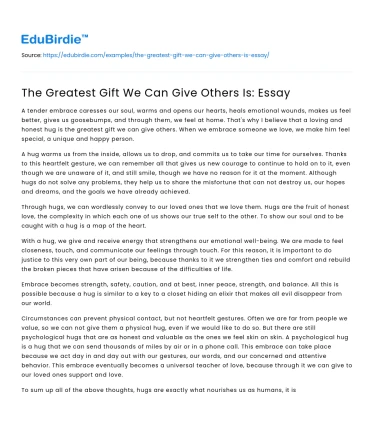Introduction
In a world characterized by rapid technological advancements and incessant demands on our time, the value of personal connection has become more critical than ever. The greatest gift we can bestow upon others is not material wealth or transient pleasures, but rather the intangible yet invaluable offerings of our time and attention. These gifts foster meaningful relationships, promote emotional well-being, and create lasting impacts on individuals and communities. As we navigate through the complexities of modern life, understanding the profound significance of giving time and attention can transform our interactions and enhance our human experience. This essay will explore why time and attention are the most precious gifts we can offer, examining their impact through real-life examples, expert opinions, and addressing potential counterarguments to strengthen this thesis.
The Power of Time and Attention
Time, the most finite resource, holds a unique position in human interactions. Unlike material gifts, time cannot be replenished or substituted, making it a potent symbol of commitment and care. When we dedicate our time to others, we send a powerful message that they are valued and important. This act of giving is a cornerstone of building and maintaining strong relationships. Studies have shown that quality time spent with loved ones is a significant predictor of relationship satisfaction (Gottman, 2000). For instance, a longitudinal study by Harvard University revealed that individuals who invested time in nurturing their personal relationships reported higher levels of happiness and health compared to those who prioritized material gains (Waldinger, 2015).
Save your time!
We can take care of your essay
- Proper editing and formatting
- Free revision, title page, and bibliography
- Flexible prices and money-back guarantee
Furthermore, attention complements time as a gift by enhancing the quality of interactions. In an era where distractions are ubiquitous, offering undivided attention is a rare and cherished gesture. Active listening, eye contact, and responsive communication are components of attentive engagement that can deepen connections and foster mutual understanding. According to psychologist Carl Rogers, “The greatest gift you can give another person is your attention, because when you pay attention to another person, you give them the gift of your true self” (Rogers, 1980). Through focused attention, we acknowledge the other person's presence and significance, which can be particularly uplifting in times of distress or uncertainty.
Transitioning from the intrinsic value of time and attention, it is crucial to consider the broader implications of these gifts on societal well-being. While the personal benefits are evident, the ripple effects extend beyond individual relationships, influencing communities and social structures. By dedicating time and attention to nurturing relationships, we contribute to a more empathetic and cohesive society. This perspective will be further explored in the next section.
Impact on Societal Well-Being
The societal benefits of giving time and attention are profound and multifaceted. When individuals engage in meaningful interactions, they contribute to the development of a supportive network that enhances communal resilience. Social capital, defined as the collective value of social networks and shared norms, thrives in environments where individuals invest time and attention in their relationships (Putnam, 2000). Communities characterized by strong social capital exhibit higher levels of trust, cooperation, and civic engagement, leading to improved public health outcomes and reduced crime rates (Kawachi & Berkman, 2001).
Real-life examples illustrate the transformative power of time and attention in community settings. Volunteer programs, such as the Big Brothers Big Sisters initiative, highlight how mentorship and dedicated time can positively influence youth development and foster a sense of belonging (Grossman & Tierney, 1998). Similarly, community-driven projects that encourage collective participation, like neighborhood clean-ups or community gardens, demonstrate how shared attention to communal goals can strengthen social bonds and enhance community pride.
Despite the evident benefits, some may argue that the demands of modern life make it challenging to consistently offer time and attention. The pressures of work, family, and personal obligations can limit our availability, potentially leading to feelings of guilt or inadequacy. However, it is essential to recognize that even small, intentional acts of giving can have significant impacts. Prioritizing quality over quantity and integrating mindful practices, such as setting boundaries and practicing gratitude, can help individuals navigate these challenges and maintain meaningful connections.
As we approach the conclusion, it is important to emphasize that while time and attention are invaluable gifts, their true power lies in the intention and authenticity behind them. The final section will synthesize the insights discussed and reinforce the central thesis of this essay.
Conclusion
In conclusion, the greatest gifts we can offer others—time and attention—transcend material possessions and superficial exchanges. These intangible offerings hold the potential to transform personal relationships and foster societal well-being. By dedicating time to those we care about and offering our undivided attention, we communicate their importance and contribute to an empathetic and connected world. While challenges exist in balancing modern demands, prioritizing meaningful interactions can lead to profound personal and communal benefits. As we strive for a more compassionate society, let us remember that the ultimate present we can give is the gift of ourselves—our time and unwavering attention. Through this lens, we can inspire and cultivate relationships that enrich our lives and the lives of others, creating a legacy of connection and care for future generations.






 Stuck on your essay?
Stuck on your essay?

